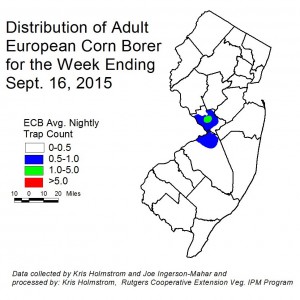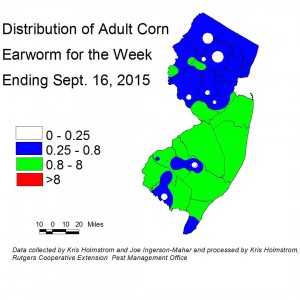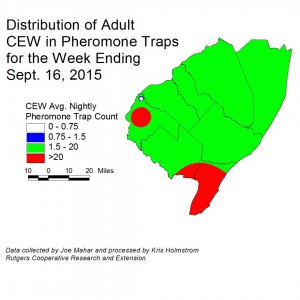Sweet Corn
Only a scattering of European corn borer (ECB) moths are being captured now, with somewhat more consistent catches in Mercer County (see ECB map). Damage from this pest is largely being overshadowed by that of the fall armyworm.
As always, consider treating when the number of infested plants in a 50 plant sample exceeds 12%. Any planting remaining at or above threshold as it proceeds to full tassel should be treated, as this is the last stage at which ECB larvae will be exposed and vulnerable to insecticidal sprays.
See the 2015 Commercial Vegetable Recommendations Guide for insecticide choices.
| The highest nightly ECB catches for the previous week are as follows: | ||
| Lawrenceville 2 | Georgetown 1 | |
| Califon 1 | Medford 1 | |
| Crosswicks 1 | Pennington 1 | |
| East Vineland 1 | ||
Corn earworm moth (CEW) activity remains steady, with low-to-moderate catches throughout the state (see CEW Map). At current levels, CEW remains a significant threat to silking sweet corn plantings.
| The highest nightly CEW blacklight trap catches for the previous week are as follows: | ||
| New Egypt 3 | Pedricktown 2 | Crosswicks 1 |
| East Vineland 2 | Phillipsburg 2 | Eldora 1 |
| Georgetown 2 | Tabernacle 2 | Folsom 1 |
| Medford 2 | Woodstown 2 | Springdale 1 |
CEW moth catches in the limited CEW pheromone trap network in the southern counties have changed very little over the past week, with the exception of moderate increases in Cape May. Overall activity is fairly consistent throughout the south, resulting in a broad area where a 4-day silk spray schedule (blue area) is recommended (see CEW blacklight map). The somewhat more conservative scale of the pheromone map indicates a 3-day schedule (green areas) in much of south Jersey. 3-day schedules are warranted throughout southern NJ at this time.
| The highest nightly CEW pheromone trap catches for the previous week are as follows: | ||
| Eldora 39 | Springdale 18 | |
| Woodstown 31 | East Vineland 7 | |
| Green Creek 19 | Beckett 1 | |
For silking sweet corn, the following spray schedules are warranted.
Silking Spray Schedules*:
South – 3 days
Central – 3 days
North – 4 days
Fall armyworm re-infestation rates remain very high. Growers of transgenic (B.t.) corn are now seeing signs of FAW infestation in harvested ears. Under this type of pressure, growers should consider a 5-7 day spray schedule on transgenic sweet corn through the silk period.
FAW do not respond well to pyrethroid insecticides. The most useful products are those in the IRAC group 28 class (Coragen, Exirel, Belt) or the IRAC group 5 class (Radiant, Entrust), or combination products including these classes. See the 2015 Commercial Vegetable Recommendations Guide for insecticides effective against FAW.
Tomatoes
Late blight remains active in a limited area of central Morris County. With heavy dews now the norm, conditions will be favorable for this disease.
All tomato growers should protect their late crops against this disease. Growers with early tomato plantings that are no longer producing a viable crop (and which are no longer being treated with fungicides) should consider eliminating these plantings as a potential inoculum source. This may be done by physically removing plants or applying a chemical desiccant to the foliage.
Pumpkins and Winter Squash
Be alert to the possibility that striped cucumber beetle may return to pumpkin and squash fields as the crop matures. These beetles may feed on rinds of mature fruit, reducing their marketability. Giant pumpkin varieties and Hubbard squash are particular favorites of this pest. If beetles are found at 2 or more sited in the field, and fresh damage is noted, consider an insecticide application. Be sure to time applications to avoid contact with bees.
Pepper Weevil
Again, no weevils have been caught in traps in the last week. As it is now the middle of September we will discontinue any further reports regarding pepper weevil. The last weevil caught was in May and there has been no infested fields reported during the growing season. Any late infestation that might occur now will cause minimal problems and except in special situations there will be no need to attempt to manage it.
Brown Marmorated Stink Bug (BMSB)
BMSB numbers remained very low in NJ blacklight traps this past week. These catches are too low to create a map. As yet, no fruit injury has been discovered in scouted pepper plantings.
Hawaiian Beet Webworm
Hawaiian beet webworm (HBWW) adults have increased in pheromone traps in southern NJ, and are active through Monmouth, Middlesex and Mercer counties. Larvae have recently been discovered in various greens in Atlantic and Gloucester counties.
This pest favors beet greens, Swiss chard and spinach, although some larvae have been found in mint plantings in the Landisville area. Damage occurs directly on leaves, with larvae spinning protective webbing on the underside of leaves. Heavy moth populations may be found in dense stands of galinsoga. Several years ago, HBWW did extensive damage to host crops like spinach from Atlantic through Monmouth County before growers were aware of the problem.
At this time, all south Jersey growers should check spinach, beet and Swiss chard plantings for signs of infestation.
Beet Armyworm
Beet armyworm (BAW) moths have hit levels of 23/night in Atlantic County and 15/night in Salem County. There have been few reports of BAW infestations in crops, but this pest can infest peppers, cole crops, tomatoes and various greens like chard and spinach. Be alert to the threat of infestation by this pest. Scout fields of the above crops weekly. BAW larvae have been observed in cole crops as far north as Hunterdon County this season.




